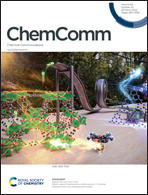Multiresonant TADF materials: triggering the reverse intersystem crossing to alleviate the efficiency roll-off in OLEDs
Abstract
The hunt for narrow-band emissive pure organic molecules capable of harvesting both singlet and triplet excitons for light emission has garnered enormous attention to promote the advancement of organic light-emitting diodes (OLEDs). Over the past decade, organic thermally activated delayed fluorescence (TADF) materials based on donor (D)/acceptor (A) combinations have been researched for OLEDs in wide color gamut (RGB) regions. However, due to the strong intramolecular charge-transfer (CT) state, they exhibit broad emission with full-width-at-half maximum (FWHM) > 70 nm, which deviates from being detrimental to achieving high color purity for future high-end display electronics such as high-definition TVs and ultra-high-definition TVs (UHDTVs). Recently, the new development in the sub-class of TADF emitters called multi-resonant TADF (MR-TADF) emitters based on boron/nitrogen atoms has attracted much interest in ultra-high definition OLEDs. Consequently, MR-TADF emitters are appeal to their potentiality as promising candidates in fabricating the high-efficient OLEDs due to their numerous advantages such as high photoluminescence quantum yield (PLQY), unprecedented color purity, and narrow bandwidth (FWHM ≤ 40 nm). Until now many MR-TADF materials have been developed for ultra-gamut regions with different design concepts. However, most MR-TADF-OLEDs showed ruthless external quantum efficiency (EQE) roll-off characteristics at high brightness. Such EQE roll-off characteristics were derived mainly from the low reverse intersystem crossing (kRISC) rate values. This feature article primarily focuses on the design strategies to improve kRISC for MR-TADF materials with some supportive strategies including extending charge delocalization, heavy atom introduction, multi-donor/acceptor utilization, and a hyperfluorescence system approach. Furthermore, the outlook and prospects for future developments in MR-TADF skeletons are described.

- This article is part of the themed collection: ChemComm Most Popular 2023 Articles


 Please wait while we load your content...
Please wait while we load your content...